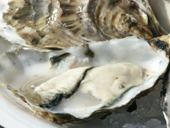
UK/Ireland
•Canada/USA
________________________________________________________________________

eat
oysters
Eating raw oysters
is a uniquely invigorating experience; a bit like battery-licking for
grown-ups. It seems that we can taste the elements they contain: zinc,
calcium, copper, iodine, magnesium. And no other food conjures up a physical
feature of the Earth as strongly as a bracing, salty, tangy oyster: the
essence of the sea in edible form.
Oysters can now be obtained throughout the year but are usually better outside of their spawning period (when the waters are colder).
HISTORY
Shells found on archaeological sites indicate that people were eating oysters 6,000 years ago (how did they open them without an oyster knife?).
For much of recorded history they have been regarded a simple form of sustenance, punctuated by occasional periods in which they reached the status of delicacy. In Britain they shifted from stomach-filler to luxury food with the arrival of the Romans, largely disappeared from the diet after they left, before returning to favor sometime around the eight century.
By Victorian times, pickled oysters were a common food of the poor in London, and in the American South in the early twentieth century the Po-Boy fuelled blue collar workers. The era of cheap oysters came to an end quite abruptly after oyster beds became exhausted due to overfishing and pollution.
BIOLOGY
Oysters are members of the family Ostreidae and the common European oyster is named Ostrea edulis. Oysters are bivalve molluscs found near the bottom of the sea in coastal areas. The upper shell (valve) is flattish and is attached by an elastic ligament hinge to the lower, bowl-shaped shell. Oysters become sexually mature at around three years old and may switch between male and female several times during their life span.
NUTRITION
Oysters are high in protein and low in fat. They are rich in zinc and contain many other minerals such as calcium, iron, copper, iodine, magnesium and selenium.
TIPS
BUYING
Oysters should be stored at a low temperature and smell briny-fresh. The
shells should be clean, bright, tightly-closed and unbroken.
Size, shape and flavor vary considerably. The best from British and Irish waters are considered to be those from Colchester, Whitstable, the Helford and Galway. Natives are pricier and generally thought of as the superior oyster. Pacific or rock oysters tend to have a frillier shell and smaller, milder meat.
STORING
Unopened (live) oysters can be kept in the fridge, covered in wet kitchen
towels, for two or three days - keep a check on them and discard any that
open. Do not store in an airtight container, or under fresh water, as
this will cause them to die.
Shucked oysters can be kept refrigerated in a sealed container for four or five days. They can also be frozen (previously frozen oysters are better for cooking than eating raw).
PREPARING
Ask your fish seller to open your oysters, retaining the shells (if required)
and liquor. If you really want to shuck your own, hold an oyster (deeper
shell down) in a hand protected with a work glove or wrapped tea towel.
Insert an oyster knife (or wide, short screwdriver) between the two halves
of the shell and gradually prize apart, working your way around to the
hinge and saving as much liquor as possible. Discard any oysters that
are dry or do not smell fresh.
Raw oysters are best with a squeeze of lemon and a pint of Guinness. A drop of Tabasco sauce can be added if desired. Cooking oysters can temper the salty tang and intensify the creaminess of the flavor. Grilling or poaching produce great results in many recipes (see below).
OTHER STUFF
"You needn't tell me that a man who doesn't love oysters and asparagus and good wines has got a soul, or a stomach either. He's simply got the instinct for being unhappy highly developed."
- Saki (Hector Hugh Munro)
PICK OF THE RECIPES
in
season:
january
february
march
april
may
june
july
august
september
october
november
december
main regions:
Central and Northern Coastal Regions
ONLINE
IN PRINT
-
Oysters with Chilli, Ginger and Red Wine Vinegar
Happy Days with the Naked Chef -
Baked Oysters with Apples
fish

